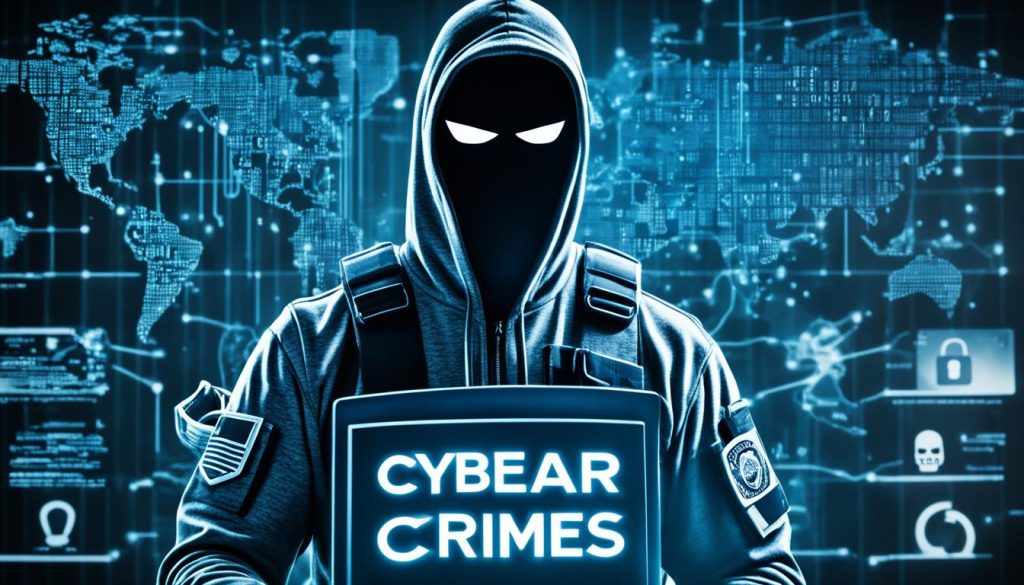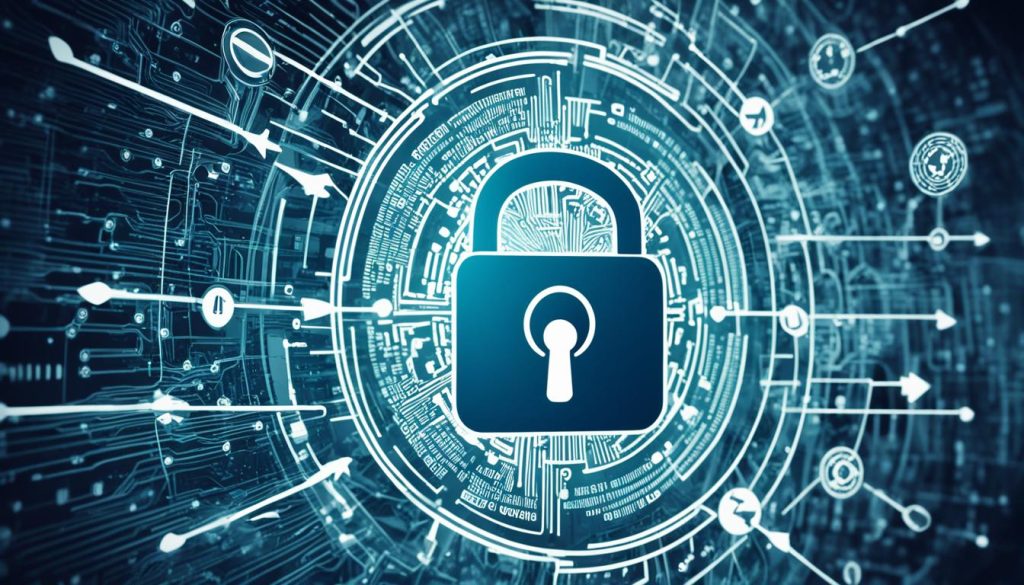In today’s digital world, cyber crimes are a big threat to everyone. They cover a lot of illegal acts, from old crimes done online to new ones made by the internet and digital tech1. Laws about cybercrime are key in setting rules for how we use the internet. They protect us, help catch and punish online criminals, and keep the internet safe.
Cybercrime laws have three main parts: substantive, procedural, and preventive. Substantive law tells us what’s right and wrong online. Procedural law explains how to apply the laws. Preventive law aims to stop and lessen cyber threats1. It’s important to understand these laws as cybercrime challenges keep getting bigger and more complex. For example, predicts cybercrime costs will jump by 5.7 trillion USD from 2023 to 2028, hitting 13.82 trillion USD by 2028, a huge 69.94% increase.
Key Takeaways
- Cybercrime law covers three main areas: substantive, procedural, and preventive to tackle online crimes.
- Cyber crimes range from old crimes done online to new ones made by technology.
- The cost of cybercrime is expected to soar, with a 69.94% increase from 2023 to 2028, says .
- Cybercrime hurts people and businesses by causing financial losses, damaging reputations, and leading to legal trouble.
- Stopping cybercrime requires a mix of tech solutions and legal rules.
Defining Cyber Crimes and Their Legal Framework
In today’s digital world, it’s key to grasp cyber crimes and their legal sides. These crimes fall into two main groups: cyber-dependent and traditional crimes in cyberspace2. Cyber-dependent crimes include hacking and malware, while traditional crimes are done online2.
Substantive Cybercrime Law and Criminal Culpability
Substantive cybercrime laws set rules against certain cybercrimes and punish breaking them2. Hacking means getting into computers without permission for things like stealing data or defacing sites2. How much someone meant to do it affects their guilt2.
| Legal System | Approach to Cybercrime Law |
|---|---|
| Common Law | Uses past court decisions to define cybercrime laws. |
| Civil Law | Has clear laws about cybercrime with set punishments. |
| Customary Law | Uses old customs to handle cybercrime in certain areas. |
| Religious Law | Uses religious beliefs to guide cybercrime laws. |
| Legal Pluralism | Accepts many legal systems, leading to complex cybercrime laws. |
Procedural Law and Criminal Procedure
Procedural law sets the rules for handling people in the criminal justice system2. In the UK, the Computer Misuse Act 1990 deals with hacking and denial of service2. It has rules about unauthorized access and disrupting computers2.
Cybercriminals vary in skill, from experts to those with basic skills but lots of tools2. Most cybercriminals are not highly skilled but use online tools to exploit vulnerabilities2. They use malware for stealing data or disrupting computers2.
“Many cybercrimes go unreported due to factors such as embarrassment, fear of retaliation, or a lack of awareness, making it challenging to quantify the extent of cybercrime and its various forms.”3
Different countries have different laws on cybercrime, making a global standard hard to set3. Cybercrimes can be for money, politics, spying, or just to cause trouble3.
Creating laws for the internet and understanding why people commit cybercrimes is key to fighting cybercrime.3
Types of Cyber Crimes and Their Legal Consequences
Cybercrime covers a broad range of illegal acts. These include both old crimes done online and new ones made possible by the internet4. These crimes can cause huge financial losses, data breaches, system failures, and harm to a company’s reputation4.
Traditional Crimes in Cyberspace
Old crimes like fraud and theft have moved to the internet4. Criminals use computer weaknesses to commit these crimes on a bigger scale4. To solve these crimes, investigators use special methods4. But, devices without strong security are easy targets for these criminals4.
Cyber-Dependent Crimes
New crimes have emerged because of the internet4. These include hacking into computer systems and disrupting them4. Criminals can work from anywhere in the world in seconds, making it hard to catch them4.
Phishing and identity theft are some of these new crimes4. Other crimes include cyberbullying and online drug sales4. Cyber extortion and intellectual property theft are also on the rise4.
| Cybercrime Incident | Impact |
|---|---|
| REvil and Kaseya Ransomware | Demanded a $70 million ransom, impacting over 1000 Kaseya customers worldwide4. |
| Stuxnet Malware | Targeted SCADA systems, causing significant damage to Iran’s nuclear power program in 20104. |
Cybercriminals keep finding new ways to exploit and harm us4. Governments and law enforcement are fighting back with new laws and techniques4.

Jurisdictional Challenges in Cyber Crimes
Cyber crimes often cross borders, making it hard for law enforcement to handle them5. This leads to forum shopping, where cases are moved to get a better outcome5. To solve this, we need international cooperation and treaties to help fight cybercrime across borders5.
When cyber crimes happen, the problem is figuring out which country can try the case6. The Neely v. Henkel case shows that being a citizen doesn’t protect you from foreign laws6.
Working together with other countries is key to fighting cybercrime6. This helps in tracking down cybercriminals and making them answer for their actions, no matter where they are6. But, getting criminals from one country to another can be tricky due to treaties and politics, letting some criminals escape6.
Cyber threats know no borders, making it hard to track down cybercriminals6. To deal with this, we need strong cyber-security and training for legal teams and police5.
A 2022 study found India and the US are most affected by cybercrime, with costs expected to rise to $10.5 trillion by 20257. Agencies like the FBI and Secret Service are key in fighting cybercrime7.
Counties work together to fight cybercrime through treaties and partnerships7. Working with private companies also helps by sharing information and resources7.

“Addressing jurisdictional challenges in cyber disputes requires international cooperation through bilateral and multilateral agreements.”5
In conclusion, fighting cyber crimes needs a global effort5. By working together, making laws stronger, and focusing on cybersecurity, we can tackle cyber disputes and protect our online world.
Privacy Concerns and Cybercrime Investigations
As we dive deeper into the digital world, finding the right balance between law enforcement and privacy is key8. Cybercrime is expected to cost the world $10.5 trillion by 2025, showing we need strong investigative steps8. But, these steps must be legal and open to protect our privacy rights.
Data collection and surveillance in cybercrime investigations bring up big privacy worries8. Over 40% of adults have faced online harassment, with women hit the hardest8. To tackle this, police must follow strict rules, get the right warrants, and keep data collection in check9. The FBI, U.S. Secret Service, ICE, U.S. Postal Inspection Service, and ATF lead in fighting cybercrime in the U.S., each with their own skills and ways to report.
Cybercrime Investigation and Privacy Safeguards
Good cybercrime investigations need strong privacy protections, like:
- Targeted surveillance to keep investigations focused and fair
- Strong security to protect data from hackers
- Clear oversight to make sure laws are followed
This way, police can keep our trust and fight cybercrime without stepping on our privacy rights8. In the U.S., the top cyber crimes include phishing, extortion, identity theft, and more8. Being careful and balanced is key to keeping our online world safe for everyone.
Keeping our privacy safe from cybercrime is tough, but we can do it with good law enforcement and strong privacy laws.
Admissibility of Digital Evidence
In today’s world, digital evidence is key in fighting cybercrime10. It’s used to prove or disprove crimes in court10. Things like emails, social media posts, and financial records can be vital clues10.
Handling and Presenting Digital Evidence
Handling digital evidence right is crucial in cybercrime cases10. It needs experts to collect and keep it safe10. Making sure the evidence is real and trustworthy is a big challenge10. Experts check it carefully to spot fake evidence10.
Rules for handling digital evidence are changing11. The ACPO (2012) is working to fight cybercrime with help from police, industry, government, and the justice system11. The Convention on Electronic Evidence (2016) talks about the problems with proving digital evidence is real11.
Experts have made rules to make sure digital evidence can be used in court12. Antwi-Boasiako and Venter (2017) came up with a model to check if digital evidence is okay to use12. Making sure digital forensics are the same everywhere is important for using digital evidence in courts12.
As technology gets better, laws need to keep up to handle digital evidence right in cybercrime cases10. Using expert analysis and following rules helps the justice system use this important info to catch cybercriminals10.
Conclusion
The digital world is changing fast, making cyber crimes and their legal implications more important. Online crime is a big challenge that needs us to understand its effects and how to fight it. Cybersecurity is key, with strategies needed to stop and catch these threats. Digital evidence is vital in solving cyber crimes, showing why we must think about privacy and rules13.
Dealing with jurisdictional challenges online is crucial for fighting cyber crime. Working together across borders is important for law makers and those fighting crime. This helps make the internet safer and ensures cybercriminals are caught13.
As cyber crime changes, it’s important to stay alert and take steps to protect yourself and others. Knowing the legal side and using cybersecurity steps can help make the internet safer for everyone14.
FAQ
What is cybercrime law, and what are its key components?
Cybercrime law sets rules for how we use technology and punishes online crimes. It protects us and helps catch and prosecute online criminals. It covers both the laws that define our rights and duties and the steps to follow when applying those laws.
What types of cybercrime are covered by the law?
The law tackles both old crimes done online, like fraud and theft, and new ones made possible by the internet. This includes hacking, altering data, and disrupting systems without permission.
How does the level of intent affect criminal culpability in cybercrime cases?
How much a person intended to do something wrong affects their guilt in cybercrime cases. Laws set out different punishments based on the intent behind the crime.
What are the challenges in investigating and prosecuting cross-border cybercrime?
Dealing with cybercrime that crosses borders is hard because of different laws and jurisdictions. Working together with other countries is key to catch and prosecute cybercriminals.
How do privacy concerns affect cybercrime investigations?
Privacy and law enforcement must balance in cybercrime cases. This balance is kept by following the law, collecting data carefully, and being open about how it’s used. Strong security and oversight are also important.
What is the importance of digital evidence in cybercrime cases?
Digital evidence is crucial in cybercrime trials. It must be handled and analyzed correctly to be accepted in court. Keeping track of who had the evidence and when is also vital.

